Drapes vs. Curtains: How to Pick the Best Window Treatment for Your Home
A Guide to the Most Common Types of Window Treatments
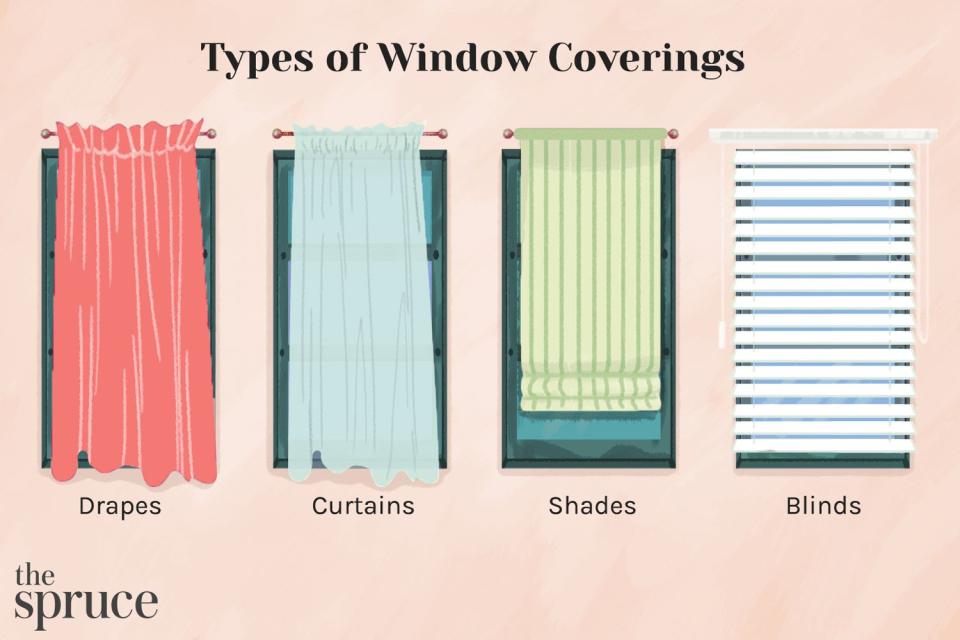
The Spruce
Fact checked by Emily Estep
When it comes to window treatments, there are several factors to consider between drapes vs. curtains, shades, and blinds. Some people use these terms interchangeably, especially drapes and curtains. However, while all four window treatment options can be used with many decorating styles and rooms, each has distinct characteristics.
Here are the similarities and differences between curtains, drapes, shades, and blinds to help you make the right selection for your needs.
The Difference Between Drapes and Curtains
Curtains are fabric panels used to cover windows and are generally cut to fit a window or drop a few centimeters below it. Drapes are also fabric panels but are typically made from thicker fabrics and cut to floor length or slightly puddle on the floor.
Drapes are the best choice for rooms that require room darkening or insulation qualities, as well as more ornate or formal spaces. Curtains are ideal for rooms that require a lighter touch or decorative element.
Blackout curtains are made from a layer of specific materials designed to block light, while drapes can be made from any variety or multiple layers of heavier fabrics. Drapes often block out light similar to blackout curtains.
How to Choose Between Drapes, Curtains, Shades, and Blinds
Curtains
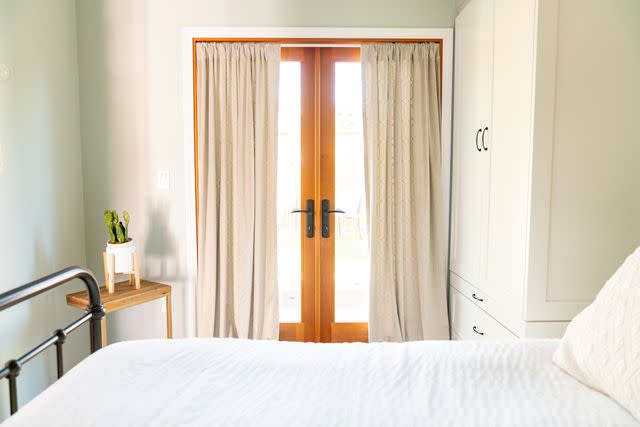
The Spruce / Almar Creative
Best for: All rooms
Common materials: Variety of fabrics
Light blocking: Sheer to blackout
Curtains are fabric panels that are often sold and hung in pairs. You’ll find curtains in a wide range of widths, lengths, fabrics, colors, and patterns. They are best for any type of room, including the living room, as they are optimal for sliding glass doors. Curtains can soften a space, as well as add color and texture.
Curtains hang from a rod, which can be plain or decorative. Some curtains have a fabric pocket sewn at the top that slips over the rod, hiding it when closed. Others have metal grommets or fabric tabs sewn at the top to slide over the rod. There also are rings or hooks that clip to the top of curtains to attach them to the rod.
Some curtains are referred to as sheers because the fabric offers minimal light blocking and privacy. For example, the short, sheer curtains that cover only the bottom half of a window over a kitchen sink—frequently matched to a valance across the window’s top—are called café curtains.
Other curtains are made of heavier fabric and might be marketed as blackout curtains, as they filter out most light. Curtains also can be used in conjunction with blinds or shades for optimal light blocking, especially in bedrooms.
The 12 Best Places to Buy Curtains of 2024
Drapes
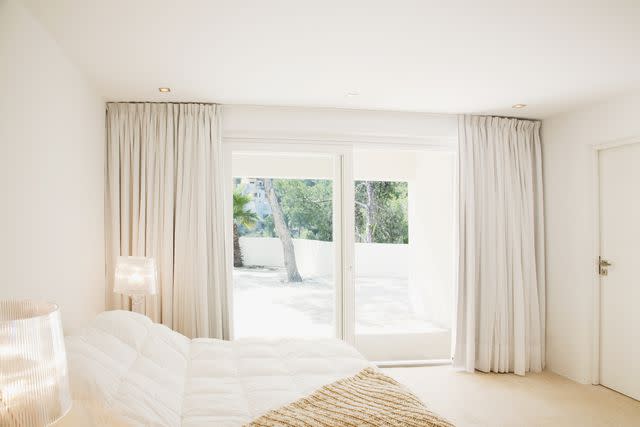
Martin Barraud / Getty Images
Best for: Bedrooms
Common materials: Variety of heavy fabrics
Light blocking: Moderate to blackout
Drapes are often lined with heavy fabric to block all outside light. This makes them best for bedrooms. Drapes are a more ornate window treatment, often made custom to specific windows. Like curtains, the purpose of drapes is to offer privacy and add visual interest to a room. The visible fabric of drapes is typically heavy and somewhat stiff, with common materials including velvet, damask, and silk.
Drape panels are often sold in pairs as window treatments. Similar to curtains, drapes hang from a rod on rings, hooks, grommets, or via a fabric sleeve. You can pick any color fabric or pattern to suit your tastes, though most drapes are solid or textured. The heaviness of drapes can project a formal feel, as the top of a drapery panel is often pleated.
Sometimes called draperies, these window treatments are typically long enough to reach from slightly above the window to the floor. They can even puddle a bit on the floor. However, no rule says that drapes have to touch the floor; that's a personal style choice.
Shades
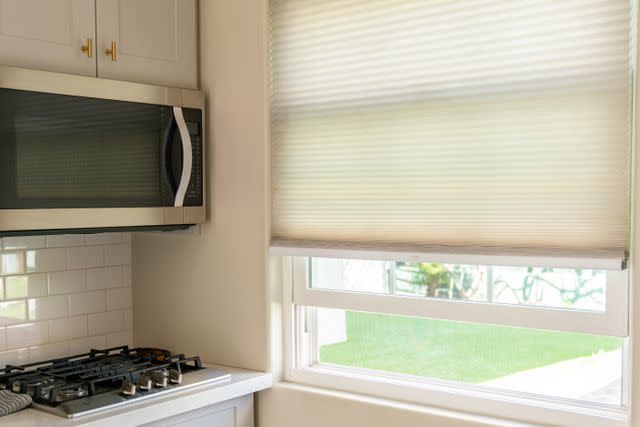
The Spruce / Almar Creative
Best for: All rooms
Common materials: Fabric, vinyl, bamboo
Light blocking: Moderate to blackout
Sold individually, shades typically come in various types of fabric, including materials like vinyl and bamboo. They are best for any type of room. Shades are attached to a rod or frame and are sized to fit within the window frame—unlike drapes or curtains, which hang below the sill.
To let in light and see outside, you need to raise the shade using either a cord, roller, or lifting mechanism. As the shade lifts, it either bunches or rolls around a rod, depending on the shade’s style.
Simple roller shades are inexpensive, and as the name suggests, the material rolls around a rod at the top. Other popular types of shades include Roman shades, which pull up into deep pleats; balloon shades, which pouf into balloons of fabric; and tie-up shades, which fasten using a fabric tie to hold them open. You can find a window shade to complement any decorating theme—from casual to formal.
While window shades can be dressy enough to use on their own, many people like to use them underneath curtains or topped with a valance. This also improves their light-blocking abilities, though shades alone can be good blackout window treatments if they're made of a thick, lined fabric.
Blinds
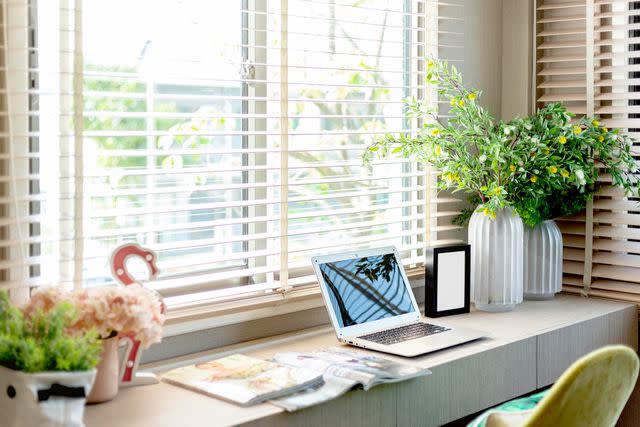
Passakorn Leelawat / EyeEm / Getty Images
Best for: All rooms
Common materials: Vinyl, wood, aluminum
Light blocking: Moderate to high
Blinds are composed of slats, also called louvers, that tilt open to let in light or closed for darkness and privacy. They are work best in any room, from the living room to the kitchen. Unlike shades, you don't have to fully raise blinds to see through them; you can just tilt them open.
Standard depths for blind slats are 1/2 inch, 1 inch, or 2 inches—the latter of which are often called Venetian blinds. The length and width of the blinds are sized to fit within the window frame. While blinds with horizontal slats are most common, there are also blinds with hanging vertical slats. These are generally used on sliding patio doors or over large sliding windows.
When it comes to blinds, some light may seep through the cracks between slats and around the edges. Still, blinds are suitable for bedrooms. And you can top them with curtains to further block light.
Blinds come in different colors and wood tones, but they're not normally patterned. Topping them with curtains or a valance will soften their rigid appearance and add some visual interest.
Things to Consider When Choosing Window Treatments
Light Filtration: Do you want your room completely blacked out for sleeping or do you prefer to have some light seeping through? Light filtration will influence whether you buy curtains (allows more light in the room) or drapes (can be room darkening).
Features: Think about what features are important to you. You can opt for electric blinds, for example, that can be operated automatically, or consider shades with a flame retardant material for safety purposes.
Header Types: There are many different header types to consider, so do some research and choose one that best fits your design aesthetic and budget. For example, you can go with pleats, grommets, a rod pocket, eyelets, and more.
Cost: Cost can vary from extremely budget-friendly to very expensive depending on the material, header type, and how much fabric is needed. For example, basic vinyl blinds are typically some of the cheapest window treatments, while wooden shutters or drapes in a luxury fabric can be some of the priciest.
Style: Finally, you'll want to think about your home's design to consider which treatment will best fit. Not only do you want to take into account aesthetics, but you'll also want to think about function. Shorter windows will do better with shades or blinds while floor-to-ceiling windows lend themselves to curtains or drapes.
Frequently Asked Questions
What is the main difference between curtains and drapes?
The main difference between curtains and drapes is that curtains are generally shorter and lighter than drapes. Curtains are used for privacy and to make your windows look more aesthetically pleasing, while drapes are used for room darkening.
What are the disadvantages of drapes?
There are a few disadvantages of drapes. Not only can heavy drapes reduce airflow, but they may also accumulate allergens and mold. They are difficult to clean and can also be pricey.
Are drapes outdated?
Drapes as a whole are classic design staples that never go out of style. However, there are certain trends and styles that come and go when it comes to modern popularity.
Layering, like combining drapes with shades, is a popular approach to window treatments today.
How high should drapes be off the floor?
It's often advised that drapes should hover just above (or about an inch above) the floor. Drapes can also puddle on the floor, but this can cause them to drag on the floor when you maneuver them and pose a tripping hazard.
Read the original article on The Spruce.

